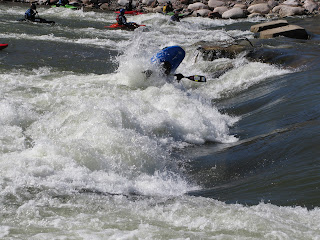The 3 Parts of the Roll
 |
| Glenwood Whitewater Park |
The Set-Up
The purpose of the set-up is to provide a familiar starting point to orient your body underwater and initiate the roll. It is also the most protected position, keeping you as safe as possible from shallow rocks and other hazards. To do the set-up, place your paddle out to the side perpendicular to your boat with the power (curved) face of the forward blade flat and facing up. Tuck your body forward and "kiss the deck". Once you are underwater in this position, reach your hands up to get your paddle out of the water. Now you can start the sweep.
The Sweep
The sweep is the motion of your body and paddle that gets you out from underneath the kayak from your set-up and out to the side so you can easily hip snap. The tricks to the sweep are to lead the motion with your head, and to keep your paddle of your forward hand (right hand if you are right handed) flat on the water and close to the surface. Get the thumb of your off-hand (your left hand again if you are right handed) on top of the bottom of your boat (get your "thumb under your butt" you will hear some people say").When your paddle is perpendicular to your kayak you will have the most leverage to perform the hip snap.
The Snap
The snap is what actually flips your boat from being upside down to rightside up. It is easiest when your body is out to the side of the boat, which is accomplished during the sweep. Here the C-to-C Roll and the Sweep Roll differ somewhat. For the C-to-C Roll you will sweep your paddle along the surface without engaging it until you are perpendicular to your boat. From there you pull directly downward and drive your nearest hip (your right hip if you are right handed) toward your paddle. For the sweep roll, you engage your paddle as soon as you start your sweep, snapping most gradually while you sweep along near the surface. you do NOT pull directly downward. If this sounds confusing, stick with the C-to-C for now, it is easier to break down when learning and take solace knowing that most people do a combination of both rolls anyway.
Now that you have hear the verbage which may or may not have been helpful depending on your learning style, check out this short video that helps provide a visualization of the movements that rolling a whitewater kayak entails:

No comments:
Post a Comment